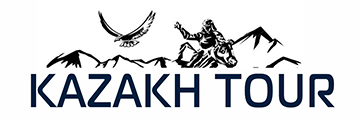The Altai Mountains run from Siberia in Russia all the way down to Mongolia’s Gobi Desert. An enormous mountain range, it covers a vast area of over 16,000 kilometres and is studded with huge glacial lakes and permanently snow-covered peaks that rise above 4,500m. One of the world’s last true wildernesses, this rugged land is the home of the Kazakh golden eagle hunters.

Shohan the hunter with his golden eagle in the Upper Dayan Valley of Mongolia. Image by David Baxendale / Lonely Planet
The Kazakh eagle hunters preserve the centuries-old tradition of riding with golden eagles to hunt for foxes, marmots and even wolves. They are nomadic and move around three times per year within the Altai Mountains.

Hunters Silou and his son Berik climb a ridge with their eagle. Image by David Baxendale / Lonely Planet
There are only a handful of eagle hunters left preserving this way of life by passing it from generation to generation for survival. Eagle hunters often wear furs of the prey caught by their eagles. Wolf and fox fur are both prized assets and essential clothing for the survival of the Kazakh nomads in the winter.

81-year-old Nubai is one of the elders. Image by David Baxendale / Lonely Planet
The Mongolian Altai is one of the least densely populated areas in the world. It is possible to travel along tracks for days without seeing another person.

The road to nowhere: dirt track to the Altai. Image by David Baxendale / Lonely Planet
Dirt trails lead from the verdant steppe up into the snow-capped mountains, making travel rigorous. Jeeps and 4×4 vehicles are often the only way to access the impassible terrain.

Ex-Russian military 4x4s traverse the rough Altai terrain. Image by David Baxendale / Lonely Planet
Tradition says that, once a boy (and in one unique case, a girl) turns 13 and has the strength to carry the weight of a golden eagle, they then take a young (usually a female) eagle, known as a Balapan, from the nest. The father trains the child to hunt with the eagle using traditional methods.

Nomads learn to hunt with eagles when they are 13 years old. Image by David Baxendale / Lonely Planet
As nomads, Kazakh eagle hunters live in ger tents, which are easily packed up and moved when the group changes location. The nomadic group typically moves three times per year and the felt-covered gers are moved each time, along with the family’s livestock, which usually includes goats, yaks, horses and sheep. Most gers have a chimney and dung burning stove inside for warmth and cooking.
Eagle hunters’ gers at dusk. Image by David Baxendale / Lonely Planet
A typical hunter’s diet includes meat from the prey that the eagles catch, as well as locally produced products like cheese. Milk is churned over a fire and then made into cheese by air drying on racks outside the ger. This is a staple of the family diet, providing important protein and fat for weathering the harsh winters.

A Kazakh woman churns milk over a fire to make cheese. Image by David Baxendale / Lonely Planet
Thirteen-year old Ashol-Pan is considered one of the only female eagle hunters in the world. Ashol-Pan is part of a nomadic family of eagle hunters and sometimes hunts with her father’s eagle near Tsambagarav, one of the highest peaks in the Altai. In July 2014, Ashol-Pan got her own golden eagle to train.

Huntress Ashol-Pan with her father’s eagle. Image by David Baxendale / Lonely Planet
Eagles are most often trained at night during the milder summer months, when temperatures in the mountains drop to around -5°C. Survival of both bird and hunter through the winter is challenging: permanent freezing conditions up to -40°C are commonplace.
Full moon at Tsambagarav. Image by David Baxendale / Lonely Planet
Winter hunts start before dawn. Golden eagle hunters ride to a high mountain ridge, over rough and frozen terrain, with their hooded birds. There they wait together until the prey moves.

Dusk falling at Tsambagarav. Image by David Baxendale / Lonely Planet
Once the prey is spotted, hunters remove the hoods, and make a call to the eagle to signal the prey is running. With vision that is seven times more powerful than the human eye, eagles quickly detect the prey and fly into the valley to make the catch.

Hunters and eagles stay together for almost a decade. Image by David Baxendale / Lonely Planet
The trained eagle then lives with the family and hunts with them for eight or nine years, after which it’s released back into the wild for the rest of its life (golden eagles live to around 25 years). It is hoped that, once released, a trained eagle will go on to breed the next generation of eagle hunters.
This is the third of a three-part photo series on Mongolian nomadic groups. Read parts one and two.
David Baxendale is a travel photographer based in Glasgow. David travelled to Altai Mountains in western Mongolia from 29 June to 15 July 2014
![]()


